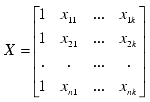Simple Linear Regression is applied to fit a linear model of the form:
![]()
to continuous variables Y and X1, X2,...Xk.
Sum of squares of the residuals is:
![]()
where i is from 1 to n, n is the number of
observations.
Estimation of b is done by the least
square estimation; that is, minimizing the SS. By taking the
derivative for each unknown b and setting
each partial derivative to zero, k+1 linear equations are used to
solve (k+1) unknown parameters.
X'X b = X'Y, where X' is the transpose
matrix of X, and



Equations are solved by LU decomposition of X and then by forward-backward substitution.
To test the Null Hypothesis H0:
![]()
vs. Alternative Hypothesis H1: at least one of them is
non-zero.

where:
![]()
is the estimated coefficient, j = 0, ...,
k.
![]() is the mean of the y1, y2, yn.
is the mean of the y1, y2, yn.
The sum of squares in the denominator above is called the Residual Sum of Squares (RSS), and the numerator of sum of squares is the Regression Sum of Squares.
Test Statistic follows F Distribution with degrees of freedom (k-l, n-k).
To test the null hypothesis estimated b j = 0, the test statistic (Tj) is calculated with the following:

where:
![]() is the jth diagonal element of the dispersion matrix
s2(X'X)-1,
and s2 is the unbiased estimator of
the variance, which is calculated as RSS/(n-k), and RSS is the
residual sum of squares.
is the jth diagonal element of the dispersion matrix
s2(X'X)-1,
and s2 is the unbiased estimator of
the variance, which is calculated as RSS/(n-k), and RSS is the
residual sum of squares.
Tj follows Student's t distribution with (n-k) degrees of freedom.
For each factor value (X), confidence interval is calculated (upper and lower Response values) using (1-a)% level of confidence, and plotted to get upper and lower bands.
![]()
where

MSR is Mean Residual Sum of Squares
![]()
SSx is corrected Sum of Squares of
X
![]()
ta/2 = Student's t (n-2) value
for a
The ellipse is determined based on the assumption that the two variables (X and Y) follow Bivariate Normal Distribution. The orientation of the ellipse is determined by the sign of the linear correlation between X and Y – the major axis of the ellipse is superimposed on the regression line. Probability (1-a) that a (X,Y) value will fall within the area that is marked by the ellipse is determined by the coefficient that defines the ellipse.
The ellipse coefficients are determined as follows:
Get the variance-covariance matrix between X and Y

It can be deduced that major and minor axes (l) of the ellipse are:
![]()
Scatter diagram of X values (Factor) and Y values (Response)
Linear Regression line (Y = aX + b)
Confidence Bands
Prediction Ellipse